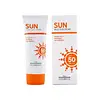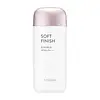What's inside
What's inside
 Key Ingredients
Key Ingredients

 Benefits
Benefits

 Concerns
Concerns

 Ingredients Side-by-side
Ingredients Side-by-side

Water
Skin ConditioningCyclopentasiloxane
EmollientCyclohexasiloxane
EmollientCobalt Titanium Oxide
Skin ConditioningAluminum Hydroxide
EmollientStearic Acid
CleansingDimethicone
EmollientZinc Oxide
Cosmetic ColorantDimethicone/Methicone Copolymer
Butylene Glycol
HumectantSodium Hyaluronate
Humectant4-Methylbenzylidene Camphor
UV AbsorberCetyl PEG/PPG-10/1 Dimethicone
EmulsifyingIsododecane
EmollientDisteardimonium Hectorite
StabilisingPropylene Carbonate
SolventDimethicone/Vinyl Dimethicone Crosspolymer
Skin ConditioningArbutin
AntioxidantOzokerite
Emulsion StabilisingMagnesium Sulfate
Methylparaben
PreservativePropylparaben
PreservativeDisodium EDTA
Parfum
MaskingWater, Cyclopentasiloxane, Cyclohexasiloxane, Cobalt Titanium Oxide, Aluminum Hydroxide, Stearic Acid, Dimethicone, Zinc Oxide, Dimethicone/Methicone Copolymer, Butylene Glycol, Sodium Hyaluronate, 4-Methylbenzylidene Camphor, Cetyl PEG/PPG-10/1 Dimethicone, Isododecane, Disteardimonium Hectorite, Propylene Carbonate, Dimethicone/Vinyl Dimethicone Crosspolymer, Arbutin, Ozokerite, Magnesium Sulfate, Methylparaben, Propylparaben, Disodium EDTA, Parfum
Hydrolyzed Chestnut Extract
Skin ProtectingCyclopentasiloxane
EmollientSilica
AbrasiveZinc Oxide
Cosmetic ColorantDipropylene Glycol
HumectantLauryl PEG-10 Tris(Trimethylsiloxy)Silylethyl Dimethicone
EmulsifyingIsopropyl Palmitate
EmollientEthylhexyl Salicylate
UV AbsorberEthylhexyl Methoxycinnamate
UV AbsorberCaprylyl Methicone
Skin ConditioningTitanium Dioxide
Cosmetic ColorantAlcohol Denat.
AntimicrobialC12-15 Alkyl Benzoate
AntimicrobialAcrylates/Dimethicone Copolymer
Skin ConditioningVp/Hexadecene Copolymer
Limonia Acidissima Extract
Skin ConditioningOpuntia Ficus-Indica Extract
Skin ConditioningVerbena Officinalis Leaf Extract
MaskingAloe Barbadensis Leaf Extract
EmollientCinnamomum Cassia Bark Extract
MaskingPsidium Guajava Leaf Extract
AstringentRosa Rugosa Flower Extract
Skin ConditioningBiosaccharide Gum-4
Skin ConditioningBis-Ethylhexyloxyphenol Methoxyphenyl Triazine
Skin ConditioningMagnesium Sulfate
Dimethicone/Vinyl Dimethicone Crosspolymer
Skin ConditioningDimethicone
EmollientDiethylamino Hydroxybenzoyl Hexyl Benzoate
UV FilterQuaternium-18 Bentonite
Aluminum Hydroxide
EmollientStearic Acid
CleansingHydrogen Dimethicone
Water
Skin ConditioningSilica Dimethyl Silylate
EmollientSodium Benzoate
MaskingTocopheryl Acetate
AntioxidantPotassium Sorbate
PreservativePolyhydroxystearic Acid
EmulsifyingIsopropyl Myristate
EmollientIsostearic Acid
CleansingLecithin
EmollientEthylhexyl Palmitate
EmollientPolyglyceryl-3 Polyricinoleate
EmulsifyingDisodium EDTA
Phenoxyethanol
PreservativeCI 77491
Cosmetic ColorantCI 77492
Cosmetic ColorantHexyl Cinnamal
PerfumingBenzyl Salicylate
PerfumingHydrolyzed Chestnut Extract, Cyclopentasiloxane, Silica, Zinc Oxide, Dipropylene Glycol, Lauryl PEG-10 Tris(Trimethylsiloxy)Silylethyl Dimethicone, Isopropyl Palmitate, Ethylhexyl Salicylate, Ethylhexyl Methoxycinnamate, Caprylyl Methicone, Titanium Dioxide, Alcohol Denat., C12-15 Alkyl Benzoate, Acrylates/Dimethicone Copolymer, Vp/Hexadecene Copolymer, Limonia Acidissima Extract, Opuntia Ficus-Indica Extract, Verbena Officinalis Leaf Extract, Aloe Barbadensis Leaf Extract, Cinnamomum Cassia Bark Extract, Psidium Guajava Leaf Extract, Rosa Rugosa Flower Extract, Biosaccharide Gum-4, Bis-Ethylhexyloxyphenol Methoxyphenyl Triazine, Magnesium Sulfate, Dimethicone/Vinyl Dimethicone Crosspolymer, Dimethicone, Diethylamino Hydroxybenzoyl Hexyl Benzoate, Quaternium-18 Bentonite, Aluminum Hydroxide, Stearic Acid, Hydrogen Dimethicone, Water, Silica Dimethyl Silylate, Sodium Benzoate, Tocopheryl Acetate, Potassium Sorbate, Polyhydroxystearic Acid, Isopropyl Myristate, Isostearic Acid, Lecithin, Ethylhexyl Palmitate, Polyglyceryl-3 Polyricinoleate, Disodium EDTA, Phenoxyethanol, CI 77491, CI 77492, Hexyl Cinnamal, Benzyl Salicylate
 Reviews
Reviews

Ingredients Explained
These ingredients are found in both products.
Ingredients higher up in an ingredient list are typically present in a larger amount.
Aluminum Hydroxide is a form of aluminum. It can be naturally found in nature as the mineral gibbsite. In cosmetics, Aluminum Hydroxide is used as a colorant, pH adjuster, and absorbent.
As a colorant, Aluminum Hydroxide may add opacity, or reduce the transparency. Aluminum hydroxide is contains both basic and acidic properties.
According to manufacturers, this ingredient is an emollient and humectant. This means it helps hydrate the skin.
In medicine, this ingredient is used to help relieve heartburn and help heal ulcers.
There is currently no credible scientific evidence linking aluminum hydroxide in cosmetics to increased cancer risk.
Major health organizations allow the use of aluminum hydroxide in personal care products and have not flagged it as a carcinogenic risk at typical usage levels.
Learn more about Aluminum HydroxideCyclopentasiloxane, or D5, is a silicone used to improve texture of products and trap moisture.
D5 is considered lightweight and volatile. Volatile means it evaporates quickly after application. Once evaporated, D5 leaves a thin barrier that helps keep skin hydrated.
It is also an emollient. Emollients help soften the skin and prevent water loss. Silicones create a silky texture in products. D5 helps other ingredients become more spreadable.
Studies show D5 is safe to use in skincare products. We recommend speaking with a skincare professional if you have concerns.
Learn more about CyclopentasiloxaneDimethicone is a type of synthetic silicone created from natural materials such as quartz.
What it does:
Dimethicone comes in different viscosities:
Depending on the viscosity, dimethicone has different properties.
Ingredients lists don't always show which type is used, so we recommend reaching out to the brand if you have questions about the viscosity.
This ingredient is unlikely to cause irritation because it does not get absorbed into skin. However, people with silicone allergies should be careful about using this ingredient.
Note: Dimethicone may contribute to pilling. This is because it is not oil or water soluble, so pilling may occur when layered with products. When mixed with heavy oils in a formula, the outcome is also quite greasy.
Learn more about DimethiconeThis ingredient is a silicone used to improve the texture of products and absorb oil. It does not get absorbed into the skin.
Like other silicones, Dimethicone/Vinyl Dimethicone Crosspolymer helps condition the skin by creating a barrier. In this sense, it can act as an emollient and trap moisture in.
This ingredient is a type of elastomer.
Learn more about Dimethicone/Vinyl Dimethicone CrosspolymerDisodium EDTA plays a role in making products more stable by aiding other preservatives.
It is a chelating agent, meaning it neutralizes metal ions that may be found in a product.
Disodium EDTA is a salt of edetic acid and is found to be safe in cosmetic ingredients.
Learn more about Disodium EDTAMagnesium Sulfate is a salt. More specifically, it is an epsom salt, or the bath salt used to help relieve muscle aches.
Despite having ‘sulfate’ in the name, it isn’t a surfactant or cleansing agent like sodium lauryl sulfate. Unlike those sulfates, magnesium sulfate doesn’t have the same cleansing or foaming properties (it's simply a type of salt).
In cosmetics, Magnesium Sulfate is used to thicken a product or help dilute other solids. It is a non-reactive and non-irritating ingredient.
One study shows magnesium deficiency may lead to inflammation of the skin. Applying magnesium topically may help reduce inflammation.
You can find this ingredient in sea water or mineral deposits.
Learn more about Magnesium SulfateStearic Acid is a fatty acid. It is an emollient, emulsifier, and texture enhancer.
As an emollient, stearic acid helps soften skin. It aids the skin's protective barrier by preventing water loss. It also provides a gentle cleansing effect without stripping away natural oils.
Stearic acid may also be used to enhance the texture of products. It can add volume and stabilize ingredients such as water and oil. This can help water and oil ingredients from separating.
Sources of stearic acid include animal or vegetable fats/oils such as coconut or shea. It can be naturally found in butter, cocoa butter, shea butter, vegetable fats, and animal tallow.
This ingredient may not be Malassezia folliculitis, or fungal-acne safe.
Learn more about Stearic AcidWater. It's the most common cosmetic ingredient of all. You'll usually see it at the top of ingredient lists, meaning that it makes up the largest part of the product.
So why is it so popular? Water most often acts as a solvent - this means that it helps dissolve other ingredients into the formulation.
You'll also recognize water as that liquid we all need to stay alive. If you see this, drink a glass of water. Stay hydrated!
Learn more about WaterZinc Oxide is a mineral broad-spectrum UV filter; it is the broadest UVA and UVB reflector approved by the FDA. It also has skin protectant and skin soothing properties.
Zinc oxide is one of the most effective broad-spectrum UV filters. It protects against UVB, UVAII, and UVAI. In comparison to its counterpart titanium dioxide, zinc oxide provides uniform and extended UVA protection.
Another great benefit? This ingredient is highly photostable so it won't degrade easily under sunlight.
A common myth is that mineral UV filters are widely believed to primarily reflect UV light.
However, modern research shows titanium dioxide absorbs UV radiation like chemical filters (~95% absorption & 5% reflection).
Zinc oxide has great skin soothing properties so you'll likely find this in sunscreens formulated for sensitive skin or babies/children. It is unlikely to cause "eye sting" like other sunscreen ingredients.
Regulatory agencies consider zinc oxide to be non-toxic and safe. It has also been shown to not penetrate the skin.
Unfortunately, this ingredient does leave a visible white cast. This is why mineral sunscreens are often less cosmetically elegant than chemical or hybrid ones.
In cosmetics, zinc oxide can be found in both non-nano and nano-sized forms. The nano version is used to reduce white cast and improve the texture of sunscreen formulas.
There are ongoing concerns surrounding nano-zinc oxide's impact on marine ecosystems and whether it can be absorbed into skin.
Regarding marine ecosystems and coral reefs, there is no conclusive evidence that any form of zinc oxide (or any other sunscreen ingredients) will cause harm. The science is still developing but many consumers are keeping a close eye on this issue.
Please note, many destinations have reef-safety sunscreen rules. For instance, the U.S. Virgin Islands advises all visitors to use non-nano mineral sunscreens.
There has also been some stir about whether micronized or nano zinc oxide has potential photoxicity and absorption through the skin/lungs.
An in-vitro (done in a test tube or petri dish) study demonstrated micronized zinc oxide to have potential phototoxicity. There's no need to fret; the EU Commission's Scientific Committee on Consumer Safety has stated, "The relevance of these findings needs to be clarified by appropriate investigations in vivo." Or in other words, further studies done on living organisms are needed to prove this.
Current research shows zinc oxide nanoparticles do not penetrate intact or sunburned skin. They either remain on the surface or in the outermost layer of dead skin (stratum corneum).
Zinc oxide is one of only two classified mineral UV filters with titanium dioxide being the other one.
Fun fact: Zinc has been used throughout history as an ingredient in paint and medicine. An Indian text from 500BC is believed to list zinc oxide as a salve for open wound. The Ancient Greek physician Dioscorides has also mentioned the use of zinc as an ointment in 1AD.
Learn more about Zinc Oxide